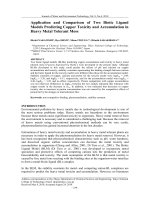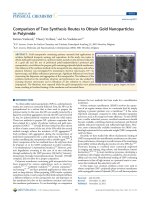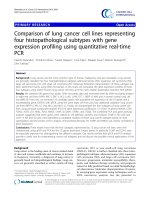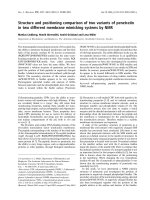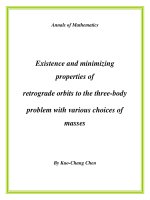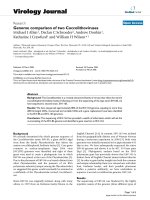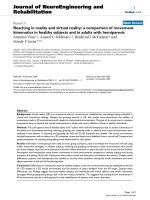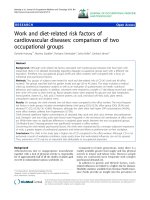Comparison of the efficiency of two algorithms which solve the shortest path problem with an emotional agent
Bạn đang xem bản rút gọn của tài liệu. Xem và tải ngay bản đầy đủ của tài liệu tại đây (349.33 KB, 16 trang )
Yugoslav Journal of Operations Research
16 (2006), Number 2, 211-226
COMPARISON OF THE EFFICIENCY OF TWO
ALGORITHMS WHICH SOLVE THE SHORTEST PATH
PROBLEM WITH AN EMOTIONAL AGENT
Silvana PETRUSEVA
Mathematics Department, Faculty of Civil Engineering,
"St. Cyril and Methodius" University, Skopje, Macedonia
Received: October 2003 / Accepted: June 2006
Abstract: This paper discusses the comparison of the efficiency of two algorithms, by
estimation of their complexity. For solving the problem, the Neural Network Crossbar
Adaptive Array (NN-CAA) is used as the agent architecture, implementing a model of an
emotion. The problem discussed is how to find the shortest path in an environment with n
states. The domains concerned are environments with n states, one of which is the starting
state, one is the goal state, and some states are undesirable and they should be avoided.
It is obtained that finding one path (one solution) is efficient, i.e. in polynomial time by
both algorithms. One of the algorithms is faster than the other only in the multiplicative
constant, and it shows a step forward toward the optimality of the learning process.
However, finding the optimal solution (the shortest path) by both algorithms is in
exponential time which is asserted by two theorems.
It might be concluded that the concept of subgoal is one step forward toward the
optimality of the process of the agent learning. Yet, it should be explored further on, in
order to obtain an efficient, polynomial algorithm.
Keywords: Emotional agent, complexity, polynomial time, exponential time, adjacency matrix,
shortest path.
1. INTRODUCTION
We shall recall some notions of the theory of complexity which will be used in
this paper.
The complexity of the algorithm is the cost of the computation measured in
running time or memory, or some other relevant unit. The complexity of the spending
time is presented as a function from the input data which describe the problem.
212
S. Petruseva / Comparison of the Efficiency of Two Algorithms
In a typical case of a computational problem some input data are given, and a
function from them should be computed. The rates of growth of different functions are
defined by symbols in order to compare the speeds with which different algorithms do
the same job. Some of these symbols, which are used here, are defined in the following
way: [8], [11]
Let f(x) and g(x) are functions from x.
Definition 1. We say that f(x)=O(g(x)), x → ∞ if ∃C , x0 so that f ( x) ≤ Cg ( x),
∀x > x0 , which means that f grows like g or slower.
Definition 2. We say that f(x) = Ω(g(x)) if holds the opposite: g(x) = O(f(x)) when
x → ∞ and ∃ε > 0, and x0, so that for x> x0 f ( x) > ε g(x).
Definition 3. We say that f(x)= Θ( g ( x)) if there are constants c1 > 0, c2 > 0 , x0 , such that
for ∀x > x0 it is true that c1g(x) < f(x) < c2g(x). We might say then that f and g are of the
same rate of growth, only the multiplicative constants are uncertain.
This definition is equivalent to the definition:
f(x)= Θ( g ( x)) means that f(x) = O(g(x)) and f(x) = Ω(g(x)) [8].
The classes of complexity are sets of languages which present an important
decision problems. The property which these languages share is that all of them can be
decided in some specific boundary of any aspect of their performances (time, space, or
other).
The classes of complexity are determined by a few parameters: the model of
computing, which can be deterministic or nondeterministic, and the resources we would
like to restrict, like time, space or other. For example, the class P is the set of languages
decided in polynomial time and the class EXP is the set of languages decided in
exponential time [2]. If the problem is solved in polynomial time, it means that it is
solved efficiently, but solving the problem in exponential time means that maybe this
problem can not be solved in an efficient way.
2. DESCRIPTION OF THE ALGORITHMS "AT GOAL GO BACK" AND
"AT SUBGOAL GO BACK"
The algorithms "at goal go back" and "at subgoal go back" solve the problem of
finding the shortest path from the starting state to the goal state in an environment with n
states. These algorithms were proposed for the first time in 1995 [3].The domains
concerned are environments with n states, one of which is the starting state, one is the
goal state, and some states are undesirable and they should be avoided. It is assumed that
a path exists from every state to the goal state and from the starting state to every state, so
there is a path from the starting state to the goal state. If the starting state can be every
other state, i.e. if the problem is finding the shortest path from whatever other state to the
goal state, then the assumption is that the graph is strongly connected, i.e. every state can
be reached from every other state. The agent approach is used for solving this problem
[3],[12]. The agent architecture used here is neural network, i.e. Neural NetworkCrossbar Adaptive Array (NN - CAA) [3]. (Fig. 1)
S. Petruseva / Comparison of the Efficiency of Two Algorithms
213
The method which CAA uses is the backward chaining method. It has 2 phases:
1) search for a goal state, and 2) when a goal state is found define the previous state as a
subgoal state. The search is performed using some searching strategy, in this case random
walk. When executing a random walk the goal state is found, then a subgoal state is
defined (with both algorithms), and with algorithm "at subgoal go back" this subgoal
becomes a new goal state. The process of moving from the starting state to the goal state
is a single run (iteration, trial) trough the graph. The next run starts again from the
starting state, and will end in the goal state. In each run a new subgoal state is defined.
The process finishes when the starting state becomes a subgoal state. That completes a
solution finding process.
Figure 1: The CAA architecture
214
S. Petruseva / Comparison of the Efficiency of Two Algorithms
The CAA has a random walk searching mechanism implemented as a random
number generator with uniform distribution. Since there is a path to the goal state by
assumption, then there is a probability that the goal will be found. As the number of steps
in a trial approaches infinity, the probability of finding a goal state approaches unity [3].
The time complexity of online search strongly depends upon the size and the
structure of the state space, and upon a priori knowledge encoded in the agent's initial
parameter values. When a priori knowledge is not available, search is unbiased and can
be exponential in time for some state spaces. Whitehead [10] has shown that for some
important classes of state spaces reaching the goal state for the first time, moving
randomly, can require number of action executions that is exponential in the size of the
state space. Because of this, the state spaces which are concerned here (described above)
are with additional assumption that the number of transitions between 2 states from the
starting state to the goal state, in every iteration is linear function of n (the number of
states).
The agent starts from the starting state and should achieve the goal state,
avoiding the undesirable states. From each state the agent can undertake one of maximum
m actions, which can lead to another state or to a certain obstacle. The agent moves
through the environment randomly, and after a few iterations it learns a policy to move
directly from the initial state to the goal state, avoiding the undesirable states, i.e. it learns
one path. After that it learns the optimal solution, the shortest path [3], [9].The criterion
of optimality is defined as minimum path length. By path we mean a sequence of arcs of
the form (j1, j2), (j2, j3), (j3, j4),..,(jk-1, jk). By length of a path we mean the sum of the
lengths of its arcs. The shortest path is the path with minimal number of arcs.
The framework for considering the CAA agent environment relation is the two –
environment framework. The environments assumed here are: 1) the genetic environment
by which the agent receives hereditary information and 2) behavioral environment, or
some kind of reality, where the agent expresses its presence and behavior Fig.2.
This framework assumes that they are performing some kind of mutual
optimization process which reflects itself on the agent. There is an optimisation loop
including the agent and the behavioral environment, and also an optimisation loop
including the agent and genetic environment. The behavioral environment optimisation
loop is actually the agent’s learning loop: this process optimises the knowledge in the
agents read/write memory. The genetic environment optimisation loop is a loop which
optimises the read/only memory of the agent. That memory represents its primary
intentions drives underlying behavior.
The task of the genetic algorithms (GA) research is to produce a read only
memory in the genetic environment, produce an agent with that memory and test the
performance of the agent in the behavioral environment. If the performance is below a
certain level, a probability exists that the agent (organism) will be removed and another
one will be generated. The objective of the optimisation process is to produce organisms
which will express a high level of performance in the behavioral environment. The main
interest is to construct an agent which will receive the genetic information and use it as a
bias for its learning (optimisation) behavior in the behavioral environment. The genetic
information received from the genetic environment is denoted as Darwinian genome.
Additional assumption of this framework is that the agent can also export a genome. The
exported genome will contain information acquired from the behavioral environment [3].
S. Petruseva / Comparison of the Efficiency of Two Algorithms
BEHAVIORAL
215
ENVIRONMENT
AGENT
GENETIC ENVIRONMENT
Figure 2:The two environment framework
The initial knowledge is memorized in the matrix Wmxn, Fig.1. The elements of
the matrix W, wij (i =1,...,m; j =1,...,n) give information for states and are used for
computing the actions, and they are called SAE - components (state - action - evolution).
Each component wij represents the emotional value toward the performing action i in a
state j. From the emotional values of performing actions, CAA computes an emotional
value of being in a state. The elements of each column (j =1,...,n) give information for the
states. The initial values of the elements of the column are all 0 if the state is neutral, with
values -1 if the state is undesirable, and with values 1 if the state is a goal. (Here, on Fig.
2 number of rows is n, number of columns is m).
The learning method for the agent is defined by 3 functions whose values are
computed in the current and the following state. They are: 1) the function for computing
an action in the current state, 2) the function for estimation of the internal state,
computed in the consequence state, and 3) the function for updating the memory,
computed in the current state.
It means that when the agent is in a state j, it chooses an action with:
1) the function for computing an action in the current state, and here it is of neural type:
i = y j = arg max {waj + sa }
a∈ A ( j )
A (j) is the set of actions in state j, sa is the action modulation variable from the higher
order system, which presents searching strategy. The simplest searching strategy is
random walk, implemented as: s = montecarlo[-0.5, 0.5] where montecarlo[interval] is
a random function which gives values uniformly distributed in the defined interval. With
this function, the agent selects the actions randomly. Having that, NN- CAA will perform
a random walk until the SAE components receive values which will dominate the
behavior.
2) the functions vk, k=1, 2,...n for computing the internal, emotional value of being in a
state in NN-CAA are computed in a "neural" fashion:
216
S. Petruseva / Comparison of the Efficiency of Two Algorithms
⎛ m
⎞
vk = sgn ⎜ ∑ wak + Tk ⎟
⎝ a =1
⎠
Tk is a neural threshold function (or warning function) whose values are:
⎧0
⎪
Tk = ⎨η k
⎪0
⎩
if
if
if
ηk = m
pk ≤ η k < m
η k < pk
where pk is the number of positive outcomes, ηk is the number of negative outcomes that
should appear in the current state. The threshold function T plays a role of a modulator of
a caution with which CAA will evaluate the states which are on the way.
3) the learning rule in NN-CAA is defined by: waj = waj + vk
SAE components in the previous state are being updated with this rule, using the
desirability of the current state.
In such a way, using crossbar computation over the crossbar elements waj, CAA
performs its crossbar emotion learning procedure which has 4 steps:
1) state j: perform an action depending on SAE components; obtain k
2) state k: compute state value using SAE components
3) state j: increment active SAE value using the k-th state value
4) j = k; go to 1
The experiment needs several iterations.
When the goal state is reached, the previous state is defined as a subgoal. The
goal is considered a consequence of the previous state, from which the goal is reached. A
subgoal is a state which has positive value for some of its elements wij. With the
algorithm "at goal go back" the agent moves randomly until it reaches the subgoal (found
in one of the previous iterations), and from that state it moves directly to the goal state,
from where a new iteration starts (because all states after that subgoal are also subgoals
and have positive values for some of its SAE component, so, from that subgoal state the
agent moves directly to the goal state). With the algorithm" at subgoal go back" the agent
doesn't go to the end goal state, but it starts a new iteration when it reaches a subgoal.
The process of learning finishes when the initial state becomes a subgoal - with both
algorithms. It means that at that moment the agent learnt one path - it learnt a policy how
to move directly from the initial state to the goal state, avoiding the undesirable states.
The algorithms guarantee finding one solution, i.e. a path from the starting state
to the goal. For solving the problem of the shortest path, another memory variable should
be introduced, which will memorize the length of the shortest path, found in one
reproduction period. The period in which the agent finds one path is called reproductive
period, and in general, in one reproductive period the agent can not find the shortest path.
After finding one path, the agent starts a new reproductive period when it learns a new
path, independent of the previous solution. The variable shortest path is transmitted to
the following agent generation in a genetic way. In this way the genetic environment is
an optimisation environment which enables memorisation of the shortest path only, in a
S. Petruseva / Comparison of the Efficiency of Two Algorithms
217
series of reproductive periods, i.e. the agent always exports the solution (the path) if it is
better (shorter) than the previous one. This optimisation period will end in finding the
shortest path with probability 1. Since the solutions are continuously generated in each
learning epoch, and since they are generated randomly and independently from the
previous solution, then, as time approaches infinity, the process will generate possible
solutions with probability 1. Among all possible solutions the best solution, the shortest
path is contained with probability 1. Since CAA will recognize and store the shortest path
length, it will produce the optimal path with probability 1 [3].
The CAA At-subgoal-go-back algorithm for finding the shortest path in a
stochastic environment is given in the next frame:
CAA AT-SUBGOAL-GO-BACK ALGORITHM:
repeat
forget the previously learnt path
define starting state
repeat
from the starting state
find a goal state moving randomly
produce a subgoal state using CAA learning method
mark the produced subgoal state as a goal state
until starting state becomes a goal state
export the solution if better than the previous one
forever
The main difference between this “At subgoal go back” and the original (1981)
“At goal go back” algorithm is that in the original one new iteration starts always when a
goal state is reached. Here the new iteration starts when a subgoal state is reached.
3. ESTIMATION OF THE COMPLEXITY OF THE ALGORITHMS
The initial knowledge for the agent is only the matrix W of the SAE
components, and the environment is given by the matrix Y which gives the connection
between the states in the graph; y[i,j] = k means that when the agent is in the state j and
chooses the action i, the consequence is the state k (i = 1,...,m; j = 1,...,n).
The domains which are concerned here are described above: with n states, some
of which are undesirable; in each state the agent can undertake one of maximum m
actions which can lead to another state or to some obstacle. Between some states there
may be return actions. The number of transitions between 2 states, in every iteration, is
linear function of n. The agent moves in the environment randomly, and after a few
iterations it learns a policy to move directly from the initial state to the goal state,
avoiding the undesirable states, i.e. it learns one path. After that it learns the optimal
solution, the shortest path.
The complexity of the algorithms is estimated for the domain shown in Fig.3.
The starting state is the state 6, the goal state is the state 10, and the undesirable
states are: 5, 13 and 20.
The complexity of the procedures which are common for both algorithms will
be estimated first, and the complexity for the main program for each of the algorithms
will be estimated after that.
218
S. Petruseva / Comparison of the Efficiency of Two Algorithms
Common procedures for both algorithms are:
(1) The procedure compX. This procedure is used for computing the function for
choosing an action in every state j.
procedure compX(j: integer);
begin
for i=1 to m do
begin
x[i] = w[i,j] + random - 0.5
end
end.
The complexity for this procedure can be estimated by Θ (m)
Figure 3: The domain for which the complexity of the algorithms is estimated
(2) The procedure maximum finds the index of the maximal element of x(i) (i = 1,…,m)
procedure maximum;
begin
max=1;
for i=2 to m do
begin
if x(i)>x(max) then
max=i
end;
end.
The complexity for this procedure can also be estimated with Θ (m).
(3) The procedure compT computes the values of the threshold function T which is
defined in sec. 2
S. Petruseva / Comparison of the Efficiency of Two Algorithms
219
procedure compT (k:integer);
begin
neg=0; pos=0;
for i=1 to m do
begin
if w[i,k]<0 then neg = neg + 1;
if w[i,k]>0 then pos = pos + 1
end;
if neg = m then T=0;
if neg
if (neg ≥ pos) and (neg < m) then T = neg
end.
The spending time for this procedure is also Θ (m).
(4) The procedure compV computes the function for estimating the emotional value for
the state k.
procedure compV (k: integer);
begin
v[k]= T;
for i=1 to m do
begin
v[k]=v[k]+w[i,k];
end;
if v[k]>0 then v[k] = 1;
if v[k]<0 then v[k] = -1
end.
The number of operations of this procedure can be also estimated by Θ (m).
(5) The procedure solution finds one solution - the path which the agent has learnt in one
reproductive period and through which it moves directly to the goal, avoiding the
undesirable states.
procedure solution;
begin
c = init;
mark[end]='goal*';
pat[k]=' ';
30
pat[k]=pat[k]+'c';
compX(c);
maximum;
d=y[max,c];
compT(d);
compV(d);
w[max,c]= w[max,c]+v[d];
if mark[d] ≠ 'goal*' then
begin
c=d; goto 30
end;
pat[k]=pat[k]+'d'
end.
This procedure can have at most (am + b)(n – p – 1) operations, because there are am + b
operations for passing from one to another state, and the maximal length of the path can
220
S. Petruseva / Comparison of the Efficiency of Two Algorithms
be n – p – 1, (p is the number of undesirable states).The complexity can be estimated by
Θ (n) (if we set am + b = const.)
(6) The procedure length memorises the smallest length of the path which the agent has
learnt, and decides whether to go to another reproductive period.
procedure length;
begin
if leng
{new reproductive period}
s=s+1;
goto 1
end;
Lmin=l; goto 200
end.
This procedure has at most 5 operations.
3.1. The complexity of one reproductive period with the algorithm "at goal go back"
The algorithm "at goal go back":
begin
s = 1; l = n-p-1; {s - counts the reproductive periods;lvariable which memorizes the lengths of the paths, the initial
value is the longest path}
1
W[i,j]=Winit [i,j](initial values );
3
a = init; {initial state}
7
compX(a);
maximum;
b = y[max,a];
if b=0 then
{if b is obstacle }
begin
w[max,a] = -1;
goto 7
end;
else
begin
compT(b);
compV(b);
w[max,a] = w[max,a] + v[b]
end;
if a = init then
begin
if[max,a]>0 then
begin
solution;
length;
end;
end;
if mark[b]='goal' then goto 3
else
begin
if mark[b]='neg' then goto7
S. Petruseva / Comparison of the Efficiency of Two Algorithms
221
else
begin
a=b; goto7
end;
end;
200 end.
The maximal number of operations for one reproductive period with this
algorithm can be (cm+d)(n+e–1)(n–p–1) + (am+b)(n–p–1), where (cm+d)(n+e–1)(n–p–1)
is the maximal number of operations from all iterations while the solution is found: it is
the maximal number of operations of one iteration: (cm+d)(n+e–1) (cm+d) - the maximal
number of operations for the transition from one to another state, (n+e–1) is the length of
the longest path by the random walk, for the domains which are described above (Fig. 3);
e - the maximal number of repetitions of two states if there are return actions between
them (the total number from all such places), (n–p–1) is the maximal number of
iterations, p - the number of undesirable states. The number of iterations is at most
n–p–1, (for learning the longest path) because in every iteration, one state has a positive
value of the function v for the estimation of the emotional state of the agent and after
maximum n–p–1 iterations the initial state will have positive value for some w[i, init],
which means that agent has learnt one path through which it can move deterministically.
(am+b)(n–p–1) is the maximal number of operations in the procedure solution. So, the
maximal number of operations can be:
f ( n) = (cm + d )(n + e − 1)(n − p − 1) + (am + b)(n − p − 1)
= ( n − p − 1)[am + b + (cm + d )(n + e − 1)]
(1)
If we set am+b= Const1, cm+d=Const2, then the complexity can be estimated by Θ (n2).
3.2 The complexity of one reproductive period with the algorithm "at subgoal go
back"
The algorithm "at subgoal go back":
begin
s = 1; l = n-p-1; {s - counts the
reproductive periods;l - variable which
memorizes the lengths of the paths, the
initial value is the longest path}
1
3
7
W[i,j]=Winit [i,j](initial values );
a = init; {initial state}
compX(a);
maximum;
b = y[max,a];
if b=0 then {if b is obstacle}
begin
w[max,a] = -1;
goto 7
end;
else
begin
compT(b);
compV(b);
w[max,a] = w[max,a] + v[b]
222
S. Petruseva / Comparison of the Efficiency of Two Algorithms
end;
if mark[b]='goal' then
begin
mark[a] = 'goal';
if a = init then
begin
solution;
length;
end;
else
goto3 {new iteration}
end;
else
begin
if mark[b]='neg' then goto7
else
begin
a=b; goto7
end;
end;
200 end.
The maximal number of operations in one reproductive period is:
g (n) = (cm + d )[(n + e − 1) + (n + e − 2) + (n + e - 3) + "
+ (n + e − (n − p − 1))] + (am + b)(n − p − 1)
(2)
where cm+d is the maximal number of operations for passing from one to another state,
and there are at most n+e–1 transitions in the first iteration, maximum n+e–2 in the
second iteration, and so on..., where e is the maximal number of repetitions of two states,
if they have return actions (the total number from all such places). There are at most
n–p–1 (p is the number of undesirable states) iterations, because in every iteration one
state becomes a goal, it means that after maximum n–p–1 iterations the initial state will
become a goal and the reproductive period in which the agent has learnt one path through
which it moves directly, avoiding the undesirable states, will end. In fact, if we compare
this algorithm with the algorithm "at goal go back", we can conclude that this algorithm
is distinguished only in the length of the iterations. The procedure solution has at most
(am+b)(n–p–1) operations, and if we put in order the first term in (2):
(cm + d )[(n + e − 1) + (n + e − 2) + (n + e - 3) + " + ( n + e − (n − p − 1))]
= (cm + d )[(n + e − 1) + (n + e − 2) + ( n + e − 3) + "
+ (e + p + 1) + (e + p ) + (e + p − 1) + (e + p − 2) + "
+1 − [(e + p ) + (e + p − 1) + (e + p − 2) + " + 1]]
⎡ (n + e − 1)(n + e) (e + p )(e + p + 1) ⎤
= (cm + d ) ⎢
−
⎥.
2
2
⎣
⎦
So, for (2) we have:
⎡ (n + e − 1)(n + e) (e + p )(e + p + 1) ⎤
g (n) = (cm + d ) ⎢
−
⎥ + (am + b)(n − p − 1) (2*)
2
2
⎣
⎦
If we put cm+d = Const1, am+b = Const2, Const1, Const2 are some constants, we can
estimate the complexity of the algorithm by Θ (n2).
S. Petruseva / Comparison of the Efficiency of Two Algorithms
223
If we compare the maximal number of operations for one reproductive period of
the algorithm "at goal go back" (1) with the maximal number of operations for one
reproductive period of the algorithm "at subgoal go back" (2*), we can conclude that the
algorithm "at subgoal go back" is faster only in a constant, i.e. for one reproductive
period these algorithms have the same speed of convergence, they differ only in the
multiplicative constants.(If we divide f(n) and g(n) we will obtain that “at subgoal go
back” is 2 times faster than “at goal go back”). We can write:
f(n)= Θ (g(n)).
4. ESTIMATION OF THE NUMBER OF REPRODUCTIVE PERIODS
The adjacency matrix [1] is used for estimation of the number of reproductive
periods.
The adjacency matrix Anxn is used for representing directed graph and it consists
of n (number of nodes of the graph) rows and columns. Its elements are 1 or 0 and show
the connection of the nodes in the graph. aij=1 if the node i is connected with the node j
with one directed arc, and aij=0 if the node i is not connected to the node j. It is known
that the element cij of the matrix Ak shows the number of paths with length k (k=1,2,...,
n–1) from the node i to the node j in the graph [1]. This assertion will be proved and it
will be used for the estimation of the number of paths from one node to another,
depending on n - the number of nodes (and m - number of arcs from a node) in the graph.
Theorem 1: If A is the adjacency matrix for the graph G with n nodes, then the element
cij of the matrix Ak shows the number of paths with length k from the node i to the node j.
Proof: (By mathematical induction): If Anxn is the adjacency matrix of the graph G with
n nodes, then the i-th row shows the connection of the i-th node with the other nodes, and
from j-th column we can read which nodes have directed arcs entering j. In fact, from the
elements of the matrix A=A1 we can read the number of paths with length 1 between the
nodes, because aij=1 if there is a path with length 1 (directed arc) from the node i to j.
1) For k=2: In A2=AA, the elements cij are computed from multiplication of the i-th row
with the j-th column: cij = ai1a1 j + ai 2 a2 j + ..... + ain anj . The product ail alj (l=1,...,n) is
nonzero if both multiplicands are nonzero, i.e. if ail = alj = 1 , which means that there is a
path with length 1 from the node i to the node l, and there is a path with length 1 from
the node l to the node j, and so there is a path with length 2 from i to j. Every nonzero
product in this sum is a path with length 2 from i to j through l (l=1,...,n), and the sum cij
is the sum of all paths with length 2 from i to j.
2) Let us assume that the assertion holds for k = s, i.e. let the element bij of As = [bij] is
equal to the number of all paths with length s from the node i to the node j.
3) Let k = s+1.
The element cij of As+1=AsA is obtained with multiplication of the elements bil
from the i-th row of As with the elements alj (l=1,...,n) from the j-th column of A:
S. Petruseva / Comparison of the Efficiency of Two Algorithms
224
cij = bi1a1 j + bi 2 a2 j + ..... + bin anj . Every nonzero product bil alj , (l=1,...,n) is the number of
paths with length s+1 from the node i to the node j through the node l, because bil is the
number of paths with length s from i to l (by the inductive assumption) and alj =1 shows
that there is an arc with length 1 from l to j; it means that there are bil paths with length
s+1 from i to j. The sum cij is the total number of paths with length s+1 from the node i to
the node j. In fact, cij from As+1 is the number of paths with length s from the node i to
those nodes l which enter the node j with arcs with length 1 - and that is the total number
of paths with length s+1 from i to j.
Since the agent learns one path in every reproductive period, it is necessary to
express the total number of paths from the initial state to the goal state as a function of
the number of states n (and the number of actions m in every state).
The following theorem gives that dependence.
The following theorem gives the estimation of the lower and upper boundary for
number of paths with length s from one node to another one, in a graph with n nodes.
Theorem 2: The number of paths with length s from the node i to the node j, bsij , can be
s−2
s−2
≤ bsij ≤ mkmax
, for s ≥ 2, where c is some constant, m is number of
estimated cm kmin
arcs which go out of i, kmin and kmax is the minimum and maximum number of arcs which
can enter certain state in the graph. (ij are indices, s-2 is power)
1− 2
1− 2
≤ 1 ≤ mkmax
, i.e.
[Note: for s=1 bsij =1, and then we have: cm kmin
cm
m
≤1≤
. The left inequality holds for every m and kmin , because c can be chosen
kmin
kmax
arbitrary, but the right inequality holds for m ≥ kmax.]
s−2
Proof: First, we can prove bsij ≤ mkmax
, by induction:
1) By the theorem 1 the number of paths with length 2 from the node i to the node j is the
number of paths from i with length 1 to those nodes which enter j with arcs with length 1,
and those are at most m paths. It means that the number of paths with length 2,
2−2
b2ij ≤ m = kmax
m.
Since this estimation doesn’t depend on j, it holds for all paths with length 2 from i. So,
b3ij =
b2iq = b2iq
∑
q enters j
1
2−2
2−2
3− 2
+ b2iq2 + ... + b2iqk ≤ kmkmax
≤ kmax mkmax
= mkmax
.
k is the number of arcs which enter j, so the maximum number of addends in the sum is k.
This estimation holds for all paths with length 3 from i.
2) Let
s −2
bsij ≤ mkmax
.
3) Then:
bsij+1 =
∑
q enters j
s−2
s−2
s −1
bsiq = bsiq1 + bsiq2 + ... + bsiqk ≤ kmkmax
≤ kmax mkmax
= mkmax
S. Petruseva / Comparison of the Efficiency of Two Algorithms
225
s−2
Now, we can prove bsij ≥ cmkmin
, by induction, also:
2− 2
1) If b2ij ≠ 0, then we can estimate b2ij ≥ cm = cmkmin
, c is constant. Since this estimation
doesn’t depend on j, it holds for all paths with length 2 from i.
If b3ij ≠ 0, then
b3ij =
b2iq = b2iq
∑
q enters j
1
2− 2
3− 2
+ b2iq2 + ... + b2iqk ≥ kmin cmkmin
= cmkmin
.
kmin ≤ k , k is the number of arcs which enter j.
2) Let
s−2
bsij ≥ cmkmin
.
3) Then:
bsij+1 =
∑
s−2
s −1
bsiq = bsiq1 + bsiq2 + ... + bsiqk ≥ kmin cmkmin
= cmkmin
q enters j
The number of all paths B from the initial state i to the goal state g is sum of all
paths from i to g with length d, d+1, d+2,…., n–1–p, where d is the length of the shortest
path, and n–1–p is the length of the longest path:
B = bdig + bdig+1 + bdig+ 2 + ..... + bnig−1− p ≥
d −2
d −1
n − p −1− 2
≥ ckmin
m + ckmin
m + ......... + ckmin
m=
d −2
2
3
n − p −1− 2 − d + 2
= ckmin
m(1 + kmin + kmin
+ kmin
+ ...... + kmin
)=
n− p −d
⎞
d −2
n − p − d −1
d − 2 ⎛ 1 − k min
2
= ckmin
m(1 + kmin + kmin
+ ... + kmin
m⎜
) = ckmin
⎟=
⎝ 1 − kmin ⎠
n− p−2
⎛ k d − 2 − kmin
= cm ⎜ min
⎝ 1 − kmin
n− p−2
d −2
⎞
⎛ kmin
⎞
− kmin
⎟ = cm ⎜
⎟
k
−
1
min
⎠
⎝
⎠
B can be estimated by:
d −2
⎡ ⎛ k n − p − 2 − kmin
Ω ⎢ m ⎜ min
⎢⎣ ⎝ kmin − 1
⎞⎤
⎟⎥ .
⎠ ⎥⎦
S - number of reproductive periods is greater or equal to B, so S can also be estimated by:
d −2
⎡ ⎛ k n − p − 2 − kmin
S = Ω ⎢ m ⎜ min
⎣⎢ ⎝ kmin − 1
⎞⎤
⎟⎥ ,
⎠ ⎦⎥
i.e. S is exponential function from n - the number of nodes.
226
S. Petruseva / Comparison of the Efficiency of Two Algorithms
5. CONCLUSION
Two algorithms: "at goal go back" and "at subgoal go back" which solve the
shortest path problem, are described in this paper. The problem is solved with the agent
architecture NN-CAA which implements the model of an emotion. To establish how
much "at subgoal go back" is faster than the original "at goal go back", an estimation of
their complexity has been made. The domains which are concerned are with n states,
some of the states are undesirable, in each state the agent can undertake one of maximum
m actions, which can lead to another state or to some obstacle. Between some states there
may be return actions. The number of transitions between 2 states in every iteration is
linear function of n.
It is obtained that the two algorithms find one solution (one path) efficiently, i.e. in
polynomial time. The algorithm "at subgoal go back" is faster in a constant than the original
one "at goal go back", because only the iterations are shorter in "at subgoal go back", but
the function v which evaluates the emotion in every state is the same for both algorithms, so
they have the same speed of convergence: f(n) = Θ (g(n)) (they differ only in a constant, for
one reproductive period). But finding the optimal solution, the shortest path, with the two
algorithms is in exponential time. It is proved that the number of paths from one node to
another one in a graph depends exponentially on the number of the states n in the graph.
It might be concluded that the concept of subgoal is one step forward toward the
optimality of the process of the agent learning, but still, it should be explored further on,
to obtain efficient, polynomial algorithm; the changes can be made in the function v
which is decisive in the process of learning.
REFERENCES
[1] Bang-Jensen, J., and Gutin, G., Digraphs, Theory, Algorithms and Applications, SpringerVerlag London Limited, 2001.
[2] Blondel, V., and Tsitsiklis J., “A survey of computational complexity results in systems and
control”, Elsevier IFAC Publication “Automatica” 36, Oxford, 2000.
[3] Bozinovski, S., “Consequence driven systems, teaching, learning and self-learning agents”,
Gocmar Press, Amherst 1995.
[4] Goldsmith, J., and Mundhenk, M., “Complexity issues in Markov decision processes”,
Proceedings of IEEE Conference on Computational Complexity, 1998, 272-280.
[5] Mansour, Y., and Singh, S., “On the complexity of policy iteration”, Proceedings of the 15-th
Conference on Uncertainty in Artifical Intelligence, Stockholm, Sweeden, 1999.
[6] Mundhenk, M., Goldsmith, J., and Allender, E., “The complexity of the policy existence
problem for finite horizon partially-observable Markov decision processes”, Proceedings of
the 25-th Mathematical Foundations of Computer Sciences, Springer Verlag, 1997, 129-138.
[7] Orponen, P., “Computational complexity of neural networks: a survey”, Nordic Journal of
Computing, 2 (1), Helsinki, Finland, 1995, 77-93.
[8] Papadimitriou, H.C., Computational Complexity, Addison -Wesley Publishing Company, San
Diego, California, 1994
[9] Petruseva, S., and Bozinovski, S., “Consequence programming: the algorithm ‘at subgoal go
back’ ”, Mathematical Bulletin, book 24 (L), 2000.
[10] Whitehead, S.D., “Reinforcement learning for the adaptive control of perception and action”,
PhD thesis, University of Rochester, 1992.
[11] Wilf, H.S., Algorithms and Complexity, Prentice-Hall, New Jersey, 1986.
[12] Wooldrige, M., “The computational complexity of agent design problems”, Fourth
International Conference on Multi-Agent Systems (ICMS), IEEE Press 2000.
